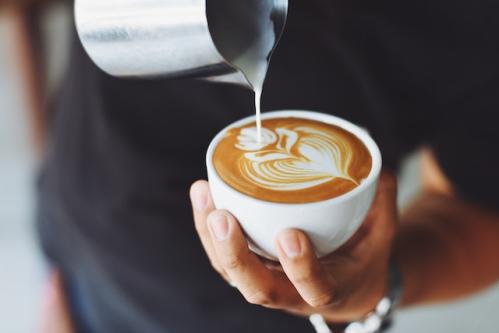随着生活节奏变快,工作压力加大,“早C(coffe)晚A(alcohol)”已成为当代打工人的续命神器。早上一杯咖啡提神,开启新一天的打工生活。咖啡,你pick美式还是拿铁咖啡?

丹麦哥本哈根大学的最新研究表明,在咖啡中加入少许牛奶或更有益健康。咖啡中含有多酚类物质,具有抗氧化和抗炎特性,可减少人体的氧化应激。研究人员通过研究多酚与氨基酸的相互作用,发现将两者结合使用对抗细胞炎症的效果是多酚单独抗氧化效果的两倍。
Coffee is a source of inflammation-fighting antioxidants. Now a new study suggests that adding a dash of milk that contains protein can boost the health benefits of your cup of coffee.
咖啡含有抗炎抗氧化剂。现在,一项新研究表明,添加少量富含蛋白质的牛奶可以增加喝咖啡的健康益处。
Researchers from the University of Copenhagen in Denmark examined how antioxidants called polyphenols interacted with amino acids, the building blocks of proteins, and found that combining them has twice the effect on fighting cellular inflammation as polyphenols alone.
丹麦哥本哈根大学的研究人员研究了抗氧化的多酚如何与氨基酸(蛋白质的组成部分)相互作用,发现将它们结合使用对抗细胞炎症的效果是单独使用多酚的两倍。
Polyphenols can be found in many foods, including coffee and tea, fruits and vegetables, red wine, and beer. Like other antioxidants, past studies suggest some polyphenols can prevent and slow the oxidation of healthy chemicals and protect our bodies from disease.
咖啡、茶、水果、蔬菜、红酒、啤酒等许多食物中都含有多酚。与其他抗氧化剂一样,研究表明,一些多酚可以防止和减缓有益化合物的氧化,保护身体免受疾病的侵害。
They are thought to do this in part by controlling inflammation, a complex immune response involving cells called macrophages that release several inflammatory mediators. Inflammation helps protect against infection, but if it isn't controlled properly, it can lead to diseases like type II diabetes, Alzheimer's, and Parkinson's.
多酚通过抑制炎症实现部分抗氧化作用,炎症是一种复杂的免疫反应,是巨噬细胞释放多种炎症介质引起的。炎症有助于防止感染,但如果控制不当,可能会导致 II 型糖尿病、阿尔茨海默病和帕金森病等疾病。
Caffeic acid (CA) and chlorogenic acid (CGA) are polyphenols that are well known to have antioxidant and anti-inflammatory effects, but the authors wanted to find out if reactions that these polyphenols have with other chemicals can further affect immune regulation.
咖啡酸 (CA) 和绿原酸 (CGA) 是公认的多酚类物质,具有抗氧化和抗炎作用。研究人员希望弄清这些多酚类物质与其他化合物的反应是否会进一步影响免疫调节。
Adducts are products that are made when two or more molecules come together. In this case, the amino acid cysteine (Cys) – found in milk products – was combined with the polyphenols CA and CGA – found in coffee – to make the adducts CA–Cys and CGA–Cys.
加合物是当两个或多个分子聚集在一起时产生的产物。在这种情况下,奶制品中的氨基酸半胱氨酸(Cys)与咖啡中的CA和CGA结合,形成加合物 CA–Cys 和 CGA–Cys。

[Photo/pexels]
To support this research, the authors successfully showed in another new study that polyphenols bind to proteins in a coffee drink with milk.
为了支持这项研究,研究人员在另一项研究中成功证明,多酚类物质与加奶咖啡中的蛋白质结合形成加合物。
"Our result demonstrates that the reaction between polyphenols and proteins also happens in some of the coffee drinks with milk that we studied. In fact, the reaction happens so quickly that it has been difficult to avoid in any of the foods that we've studied so far," says food scientist and co-author on both studies, Marianne Nissen Lund.
这两项研究的共同作者、食品科学家玛丽安·尼森·隆德称:“我们的研究结果表明,多酚和蛋白质之间的反应也发生在我们研究的一些含牛奶的咖啡饮品中。事实上,这种反应发生得非常迅速,我们研究的对象都发生了这种反应。”
In this study, the researchers used RNA-sequencing to study the immune-regulating effects of CA–Cys and CGA–Cys in macrophage cells subjected to artificial inflammation.
在这项研究中,研究人员使用 RNA 测序来分析 CA–Cys 和 CGA–Cys 在有炎症的巨噬细胞中的免疫调节作用。
They also tested the effects of CA and CGA alone and compared them to a control group of macrophages not exposed to the polyphenols or the Cys adducts.
他们还单独测试了 CA 和 CGA 的作用,并将它们与未暴露于多酚或 Cys 加合物的巨噬细胞对照组进行了比较。
As they expected, the polyphenols CA and CGA inhibited inflammatory responses, in particular the production of reactive oxygen species (ROS), prostaglandin E2 (PGE2), and the cytokines interleukin-6 and tumor necrosis factor (TNF).
正如预期那样,多酚 CA 和 CGA 抑制了炎症反应,特别是活性氧 (ROS)、前列腺素 E2 (PGE2) 以及细胞因子白细胞介素 6 和肿瘤坏死因子 (TNF) 的产生。
But when polyphenols CA and CGA were combined with amino acid cysteines found in milk proteins, their anti-inflammatory effects received a boost.
但当CA和CGA与牛奶蛋白中的半胱氨酸结合时,它们的抗炎作用得到了强化。
Macrophage cells exposed to polyphenols on their own, for instance, showed more than 2.5 times as much TNF activity as they did in the face of a polyphenols-cysteine adduct.
例如,暴露于多酚中的巨噬细胞表现出的 TNF 活性是其暴露于多酚-半胱氨酸加合物时的 2.5 倍以上。
The only exception was ROS, which inexplicably increased in the macrophage when the polyphenol-amino acid combo was present compared to when the polyphenol was on its own.
唯一的例外是活性氧,当多酚-氨基酸加合物存在时,与多酚单独存在时相比,巨噬细胞中活性氧莫名增加。
"It is interesting to have now observed the anti-inflammatory effect in cell experiments. So, the next step will be to study the effects in animals," says immunologist and senior author Andrew Williams.
免疫学家和资深作者安德鲁·威廉姆斯表示:“现在在细胞实验中观察到抗炎作用很有趣。因此,下一步我们将进行动物实验。”
Further research is needed to figure out why and what these results mean practically for human health. This study only examined how a single type of immune mediator reacts to coffee-like chemicals in a laboratory setting.
需要进一步的研究来弄清楚这些结果对人类健康的实际意义和效果。这项研究仅验证了一种类型的免疫介质在实验室环境中如何对咖啡类化学物质产生反应。
"Our results can be used as an important reference in applications of adducts formed from phenolic compounds and amino acids in future functional food or medicinal products that aim to modulate metabolic, neurological, or immune-related diseases," the researchers conclude in their paper.
研究人员在论文中总结道:“我们的研究结果可以作为未来功能性食品或药品中酚类化合物和氨基酸形成的加合物应用的重要参考,这些产品可用于调节代谢、神经或免疫相关疾病。”
The research has been published in the Journal of Agricultural and Food Chemistry.
这项研究发表在《农业与食品化学杂志》上。
来源:Science Alert